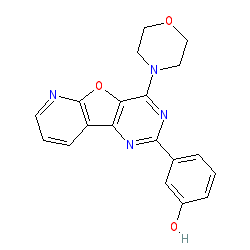GtoPdb is requesting financial support from commercial users. Please see our sustainability page for more information.
|
Synonyms: compound 2 [PMID: 17601739] | PI 103 | PIK 103
Compound class:
Synthetic organic
Comment: The discovery of PI-103 is described in [5], where it is compound 10e. It was originally identified as a PI3Kα/β inhibitor, but has subsequently been found to inhibit catalytic activity of all four PI3K subunits (α, β, γ and δ) [8].
Ligand Activity Visualisation ChartsThese are box plot that provide a unique visualisation, summarising all the activity data for a ligand taken from ChEMBL and GtoPdb across multiple targets and species. Click on a plot to see the median, interquartile range, low and high data points. A value of zero indicates that no data are available. A separate chart is created for each target, and where possible the algorithm tries to merge ChEMBL and GtoPdb targets by matching them on name and UniProt accession, for each available species. However, please note that inconsistency in naming of targets may lead to data for the same target being reported across multiple charts. ✖ |
|
|||||||||||||||||||||||||||||||||||
| No information available. |
Mechanism Of Action and Pharmacodynamic Effects  |
| The phosphatidylinositide 3-kinase family is involved in various aspects of cellular homeostasis and is deregulated in a number of pathophysiologic conditions. As a result, inhibitors of this kinase family are keenly investigated as therapeutics for immunological, cardiac and cancer indications. PI-103 inhibits angiogenesis, cell invasion, and metastasis, and has direct antiproliferative effects [3,7-8]. |







